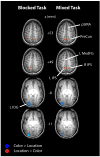fMRI evidence for both generalized and specialized components of attentional control
- PMID: 17916338
- PMCID: PMC2710450
- DOI: 10.1016/j.brainres.2007.07.097
fMRI evidence for both generalized and specialized components of attentional control
Abstract
A central question in the study of selective attention is whether top-down attentional control mechanisms are generalized or specialized for the type of information that is to be attended. The current study examined this question using a voluntary orienting task that cued observers to attend to either one of two locations or to one of two colors. Location (spatial) and color (nonspatial) conditions were presented either randomly intermixed within the same block of trials or in separate blocks. Functional magnetic resonance imaging revealed that directing attention to a location or to a color activated a network of overlapping dorsal frontal and parietal areas, previously implicated in attentional control. The pattern of observed overlap was not affected by the intermixed versus blocked presentation of location and color conditions. Although portions of the frontal-parietal network were more active in response to location cues than to color cues, a secondary analysis also revealed that medial dorsal frontal and parietal cortex were specifically engaged in shifting visual attention regardless of the cued dimension (location or color). Together, the present results support the conclusion that attentional control is the combination of a generalized network that works in concert with subregions of the frontoparietal network that are highly specialized for directing attention based on the content of the to-be-attended information.
Figures





Similar articles
-
Neural mechanisms of top-down control during spatial and feature attention.Neuroimage. 2003 Jul;19(3):496-512. doi: 10.1016/s1053-8119(03)00162-9. Neuroimage. 2003. PMID: 12880783 Clinical Trial.
-
Shifting visual attention in space: an electrophysiological analysis using high spatial resolution mapping.Clin Neurophysiol. 2000 Jul;111(7):1241-57. doi: 10.1016/s1388-2457(00)00313-8. Clin Neurophysiol. 2000. PMID: 10880800 Clinical Trial.
-
Feature-specific attentional priority signals in human cortex.J Neurosci. 2011 Mar 23;31(12):4484-95. doi: 10.1523/JNEUROSCI.5745-10.2011. J Neurosci. 2011. PMID: 21430149 Free PMC article.
-
The neural mechanisms of top-down attentional control.Nat Neurosci. 2000 Mar;3(3):284-91. doi: 10.1038/72999. Nat Neurosci. 2000. PMID: 10700262
-
Dissociating top-down attentional control from selective perception and action.Neuropsychologia. 2001;39(12):1277-91. doi: 10.1016/s0028-3932(01)00117-8. Neuropsychologia. 2001. PMID: 11566311 Review.
Cited by
-
Measuring auditory selective attention using frequency tagging.Front Integr Neurosci. 2014 Feb 5;8:6. doi: 10.3389/fnint.2014.00006. eCollection 2014. Front Integr Neurosci. 2014. PMID: 24550794 Free PMC article.
-
The Microstructure of Attentional Control in the Dorsal Attention Network.J Cogn Neurosci. 2021 May 1;33(6):965-983. doi: 10.1162/jocn_a_01710. J Cogn Neurosci. 2021. PMID: 34428795 Free PMC article.
-
Top-down activation of shape-specific population codes in visual cortex during mental imagery.J Neurosci. 2009 Feb 4;29(5):1565-72. doi: 10.1523/JNEUROSCI.4657-08.2009. J Neurosci. 2009. PMID: 19193903 Free PMC article.
-
A hierarchy of attentional priority signals in human frontoparietal cortex.J Neurosci. 2013 Oct 16;33(42):16606-16. doi: 10.1523/JNEUROSCI.1780-13.2013. J Neurosci. 2013. PMID: 24133264 Free PMC article.
-
Different Cortical Mechanisms for Spatial vs. Feature-Based Attentional Selection in Visual Working Memory.Front Hum Neurosci. 2016 Aug 17;10:415. doi: 10.3389/fnhum.2016.00415. eCollection 2016. Front Hum Neurosci. 2016. PMID: 27582701 Free PMC article.
References
-
- Awh E, Armstrong KM, Moore T. Visual and oculomotor selection: links, causes and implications for spatial attention. Trends Cogn Sci. 2006;10:124–130. - PubMed
-
- Banich MT, Milham MP, Atchley R, Cohen NJ, Webb A, et al. fMRI studies of Stroop tasks reveal unique roles of anterior and posterior brain systems in attentional selection. J Cogn Neuroscience. 2000;12(6):988–1000. - PubMed
-
- Buckner RL, Goodman J, Burock M, Rotte M, Koutstaal W, Schacter D, Rosen BR, Dale AM. Functional–anatomic correlates of object priming in humans revealed by rapid presentation event-related fMRI. Neuron. 1998;20:285–296. - PubMed
-
- Burock MA, Buckner RL, Woldorff MG, Rosen BR, Dale AM. Randomized event-related experimental designs allow for extremely rapid presentation rates using functional MRI. NeuroReport. 1998;9:3735–3739. - PubMed
Publication types
MeSH terms
Grants and funding
LinkOut - more resources
Full Text Sources

